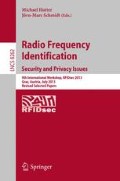Abstract
Wrong medication is an important problem of the citizens of many countries. Using contemporary technologies like UHF Gen-2 RFID tags helps decreasing the medication errors, experienced by many. As UHF Gen-2 tags have limited capacity, cryptographic algorithms cannot be accommodated. The only available functions PRNG and CRC cannot be used instead of cryptographic algorithms. To overcome the known weaknesses, various grouping protocols have been proposed. But, each protocol has some deficiencies. Two of those protocols are covered in this study. Some of their common deficiencies are studied and solutions are suggested.
Access this chapter
Tax calculation will be finalised at checkout
Purchases are for personal use only
References
Eurobarometer 2006 survey on medical errors. Technical Report, October 2005 (2006)
Kaushal, R., Bates, D.W., Landrigan, C., McKenna, K.J., Clapp, M.D., Federico, F., Goldmann, D.A.: Medication errors and adverse drug events in pediatric inpatients. JAMA 285(16), 2114–2120 (2001)
Reporting, E., Meaders, S., Hickner, J., Kuo, G.M., Fagnan, L.J., Forjuoh, S.N., Stevens, B.K., Pace, W.D., Hamlin, B.N., Scherer, H., Hudson, B.L., Oppenheimer, C.C.: Field test results of a new ambulatory care medication error and adverse drug. Ann. Family Med. 8, 517–525 (2010)
2010 National Patient Safety Goals (NPSGs) (2010)
Wal-Mart details its RFID journey. http://www.computerworld.com/s/article/109132/Wal_Mart_details_its_RFID_journey
Information technology - Radio frequency identification for item management - Part 6: Parameters for air interface communications at 860 MHz to 960 MHz. http://www.iso.org/iso/iso_catalogue/catalogue_tc/catalogue_detail.htm?csnumber=46149
Prop, E.I.: EPC Global Class1 Gen2 RFID Specifications, December 2005 (2006)
Juels, A.: Yoking-proofs for RFID tags. In: Second IEEE Annual Conference on Pervasive Computing and Communications Workshops, pp. 14–17, 138–143. IEEE Press, New York (2004)
Saito, J., Sakurai, K.: Grouping proof for RFID tags. In: Conference on Advanced Information Networking and Applications, pp. 621–624. Taichung (2005)
Peris-Lopez, P., Orfila, A., Hernandez-Castro, J.C., van der Lubbe, J.C.: Flaws on RFID grouping-proofs. Guidelines for future sound protocols. J. Netw. Comput. Appl. 34(3), 833–845 (2011)
Wu, F., Kuo, F., Liu, L.W.: The application of RFID on drug safety of inpatient nursing healthcare. In: 7th International Conference on Electronic Commerce, pp. 85–92, New York (2005)
Sun, P.R., Wang, B.H., Wu, F.: A new method to guard inpatient medication safety by the implementation of RFID. J. Med. Sys. 32, 327–332 (2008)
Chen, C.-L., Wu, C.-Y.: Using RFID yoking proof protocol to enhance inpatient medication safety. J. Med. Sys. 36, 2849–2864 (2012)
Huang, H.H., Ku, C.Y.: A RFID grouping proof protocol for medication safety of inpatient. J. Med. Sys. 33(6), 467–474 (2008)
Chien, H.Y., Yang, C.C., Wu, T.C., Lee, C.F.: Two RFID-based solutions to enhance inpatient medication safety. J. Med. Sys. 35(3), 369–375 (2011)
Yen, Y.C., Lo, N.W., Wu, T.C.: Two RFID-based solutions for secure inpatient medication administration. J. Med. Sys. 36(5), 2769–2778 (2012)
van Deursen, T., Radomirović, S.: Algebraic attacks on RFID protocols. In: Markowitch, O., Bilas, A., Hoepman, J.-H., Mitchell, C.J., Quisquater, J.-J. (eds.) WISTP 2009. LNCS, vol. 5746, pp. 38–51. Springer, Heidelberg (2009)
Peris-Lopez, P., Orfila, A., Mitrokotsa, A., van der Lubbe, J.C.A.: A comprehensive RFID solution to enhance inpatient medication safety. Int. J. Med. Inform. 80, 13–24 (2011)
Wickboldt, A.K., Piramuthu, S.: Patient safety through RFID: vulnerabilities in recently proposed grouping protocols. J. Med. Sys. 36(2), 431–435 (2012)
Kasper, T., von Maurich, I., Oswald, D., Paar, C.: Chameleon: a versatile emulator for contactless smartcards. In: Rhee, K.-H., Nyang, D. (eds.) ICISC 2010. LNCS, vol. 6829, pp. 189–206. Springer, Heidelberg (2011)
Redemske, R., Fletcher, R.: Design of UHF RFID emulators with applications to RFID testing and data transport. In: Fourth IEEE Workshop on Automatic Identification Advanced Technologies (AutoID 2005), pp. 193–198 (2005)
Wu, S., Chen, K., Zhu, Y.: A secure lightweight RFID binding proof protocol for medication errors and patient safety. J. Med. Sys. 36(5), 2743–2749 (2012)
Yu, Y.C., Hou, T.W., Chiang, T.C.: Low cost RFID real lightweight binding proof protocol for medication errors and patient safety. J. Med. Sys. 36(2), 823–828 (2012)
Peris-Lopez, P., Hernandez-Castro, J.C., Estevez-Tapiador, J.M., Ribagorda, A.: LAMED—A PRNG for EPC Class-1 Generation-2 RFID specification. Comput. Stand. Interfaces 31(1), 88–97 (2009)
Feldhofer, M., Wolkerstorfer, J.: Hardware implementation of symmetric algorithms for RFID security. In: Kitsos, P., Zhang, Y. (eds.) RFID Security, pp. 373–415. Springer, New York (2009)
Martín, H., Millán, E.S., Entrena, L., César, J., Castro, H.: AKARI-X: a pseudorandom number generator for secure lightweight systems. In: 17th IEEE IOLTS, pp. 228–233 (2011)
Health Level Seven International. http://www.hl7.org/implement/standards/index.cfm?ref=nav
Hawrylak, P.J., Schimke, N., Hale, J., Papa, M.: Security risks associated with radio frequency identification in medical environments. J. Med. Sys. 536(6), 3491–3505 (2012)
Mifare DesFire EV1 Leaflet. http://www.nxp.com/products/identification_and_security/smart_card_ics/mifare_smart_card_ics/mifare_desfire/
Oren, Y., Box, P.O.: A low-resource public-key identification scheme for RFID tags and sensor nodes a brief description of the protocol. In: WiSec 2009, pp. 59–68 (2009)
Author information
Authors and Affiliations
Corresponding author
Editor information
Editors and Affiliations
Rights and permissions
Copyright information
© 2013 Springer-Verlag Berlin Heidelberg
About this paper
Cite this paper
Özcanhan, M.H., Dalkılıç, G., Utku, S. (2013). Is NFC a Better Option Instead of EPC Gen-2 in Safe Medication of Inpatients. In: Hutter, M., Schmidt, JM. (eds) Radio Frequency Identification. RFIDSec 2013. Lecture Notes in Computer Science(), vol 8262. Springer, Berlin, Heidelberg. https://doi.org/10.1007/978-3-642-41332-2_2
Download citation
DOI: https://doi.org/10.1007/978-3-642-41332-2_2
Published:
Publisher Name: Springer, Berlin, Heidelberg
Print ISBN: 978-3-642-41331-5
Online ISBN: 978-3-642-41332-2
eBook Packages: Computer ScienceComputer Science (R0)

